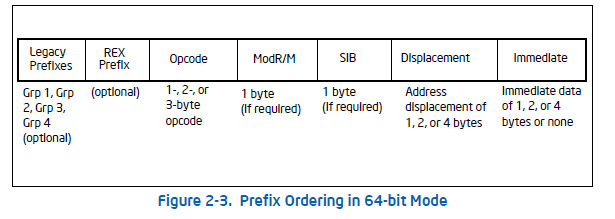1、背景
仅针对JVM的模板解释器:
如何根据opcode和寻址模式,将bytecode生成汇编码。
本文的示例中所使用的字节码和汇编码,请参见上篇博文:按值传递还是按引用?
2、寻址模式
本文不打算深入展开寻址模式的阐述,我们聚焦Intel的IA32-64架构的指令格式:

简要说明下,更多的请参考intel的手册:
– Prefixes : 用于修饰操作码Opcode,赋予其lock、repeat等的语义.
– REX Prefix:
—- Specify GPRs and SSE registers.
—- Specify 64-bit operand size.
—- Specify extended control registers.
–Opcode:操作码,如mov、push.
–Mod R/M:寻址相关,具体见手册。
–SIB:和Mod R/M结合起来指定寻址。
–Displacement:配合Mod R/M和SIB指定寻址。
–Immediate:立即数。
对上面的Opcode、Mod R/W、SIB、disp、imm如果不明白,看句汇编有个概念:
%mov %eax , %rax,-0x18(%rcx,%rbx,4)
如果这句汇编也不太明白,那么配合下面的:
– Base + (Index ∗ Scale) + Displacement – Using all the addressing components together allows efficient
indexing of a two-dimensional array when the elements of the array are 2, 4, or 8 bytes in size.
3、合法的值(64位)
关注下这4个参数的合法取值:
• Displacement — An 8-bit, 16-bit, or 32-bit value.
• Base — The value in a 64-bit general-purpose register.
• Index — The value in a 64-bit general-purpose register.
• Scale factor — A value of 2, 4, or 8 that is multiplied by the index value.
4、Mod R/M(32位寻址)
我们在后文将会用到Mod R/M字节,所以将32位寻址的格式贴在这里:

上表的备注,其中第1条将在我们的示例中用到,所以这里留意下:
The [--][--] nomenclature means a SIB follows the ModR/M byte.
The disp32 nomenclature denotes a 32-bit displacement that follows the ModR/M byte (or the SIB byte if one is present) and that is
added to the index.The disp8 nomenclature denotes an 8-bit
5、SIB(32位寻址)
同样,因为用到了Mod R/M字节,那么SIB字节也可能要用到:

6、示例
6.1、准备工作
来看个实际的例子。
下面的代码是生成mov汇编码:
void Assembler::movl(Address dst, Register src) { InstructionMark im(this);
prefix(dst, src);
emit_int8((unsigned char)0x89);
emit_operand(src, dst);
}prefix(dst,src)就是处理prefix和REX prefix,这里我们不关注。
emit_int8((unsigned char) 0x89)顾名思义就是生成了一个字节,那字节的内容0×89代表什么呢?
先不急,还有一句emit_operand(src,dst),这是一段很长的代码,我们大概看下:
void Assembler::emit_operand(Register reg, Register base, Register index,
Address::ScaleFactor scale, int disp,
RelocationHolder const& rspec,
int rip_relative_correction) {
relocInfo::relocType rtype = (relocInfo::relocType) rspec.type(); // Encode the registers as needed in the fields they are used in
int regenc = encode(reg) << 3;
int indexenc = index->is_valid() ? encode(index) << 3 : 0;
int baseenc = base->is_valid() ? encode(base) : 0; if (base->is_valid()) { if (index->is_valid()) {
assert(scale != Address::no_scale, "inconsistent address"); // [base + index*scale + disp]
if (disp == 0 && rtype == relocInfo::none &&
base != rbp LP64_ONLY(&& base != r13)) { // [base + index*scale]
// [00 reg 100][ss index base]
/**************************
* 关键点:关注这里
**************************/
assert(index != rsp, "illegal addressing mode");
emit_int8(0x04 | regenc);
emit_int8(scale << 6 | indexenc | baseenc);
} else if (is8bit(disp) && rtype == relocInfo::none) { // ...
} else { // [base + index*scale + disp32]
// [10 reg 100][ss index base] disp32
assert(index != rsp, "illegal addressing mode");
emit_int8(0x84 | regenc);
emit_int8(scale << 6 | indexenc | baseenc);
emit_data(disp, rspec, disp32_operand);
}
} else if (base == rsp LP64_ONLY(|| base == r12)) { // ...
} else { // ...
}
} else { // ...
}
}上面的代码的关注点已经标出,这里我们将其抽出,并将前文中的emit_int8((unsigned char) 0x89)结合起来:
emit_int8((unsigned char) 0x89) emit_int8(0x04 | regenc); emit_int8(scale << 6 | indexenc | baseenc);
最终其生成了如下的汇编代码(64位机器):
mov %eax,(%rcx,%rbx,1)
好了,问题来了:
上面这句汇编怎么得出的?
6.2、计算过程
我们给个下面的值:
regenc = 0x0,scale << 6 | indexenc | baseenc = 25
进行简单的运算就可以得到:
emit_int8((unsigned char) 0x89) //得到0x89emit_int8(0x04 | regenc); //得到0x04emit_int8(scale << 6 | indexenc | baseenc); //得到0x19
合起来就是三个字节:
0x89 0x04 0x19
1、0×89对应什么?

从上表可以看出因为JVM工作在64位下,所以需要配合REX.W来“起头”,不过在我们这个例子中,其恰好是0。
主要看那个89/r:
MOV r/m64,r64 //64位,将寄存器中的值给到寄存器或者内存地址中
2、0×04代表什么?
现在我们要用到上面的Mod R/M表和SIB表了。
用第二个字节0×04查Mod R/M表,可知源操作数是寄存器EAX,同时可知寻址类型是[--][--]类型,含义为:
The [--][--] nomenclature means a SIB follows the ModR/M byte.
3、0×19代表什么?
继续查SIB表,对应字节0×19的是:
base = ECX scaled index = EBX
4、汇编代码:
//32位mov %eax,%(ecx,ebx,1)//64位mov %rax,%(rcx,rbx,1)
7、结语
本文简要探讨了:
如何根据opcode和寻址模式,将bytecode生成汇编码。

 随时随地看视频
随时随地看视频



